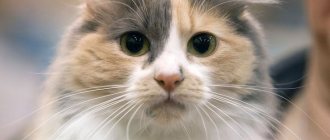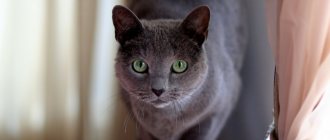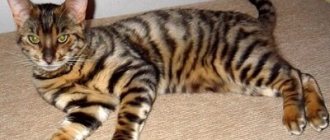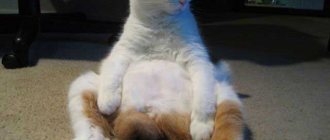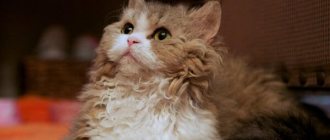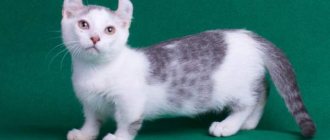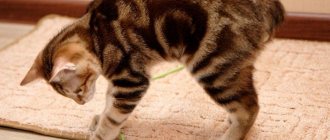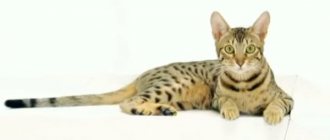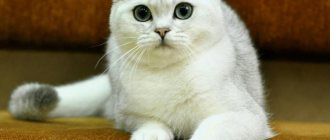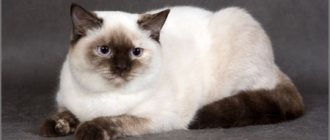Why does a cat have big ears?
The opinion that the larger the ears a cat has, the better it hears, is wrong. The size of the auricle does not affect hearing acuity. Almost all cats have ears that are quite large, but due to the individual structure of the head and the length of the fur, they may appear much smaller than they actually are. Nevertheless, there are breeds whose representatives can boast of really rather large ears. This feature has its pros and cons.
Oriental breed cat
Large ears are characteristic of breeds originating from hot countries. Lop-eared animals are able to cool themselves, which is necessary in high ambient temperatures. The improved heat transfer function is provided by nature. Large ears are penetrated by a dense network of blood vessels. As the air temperature rises, blood circulation accelerates and the animal cools down.
You will be surprised, but in fact, there are no cats with small ears. Of course, if we judge only by ears, we can identify the record holders. However, if we consider the proportions of the body as a whole, the size of the ears is most often proportional and harmonious. Perhaps it’s worth immediately announcing the winner of the “Cat with the Biggest Ears” competition – this is the African Serval, far from being a “couch” pet.
So why does a cat need big ears? As mentioned earlier, all cats, regardless of the shape and size of their ears, hear equally well. Few people know that even a dozing cat carefully “probes” the entire situation around it. High-pitched sounds, almost ultrasound, with which rodents communicate, are discernible to a cat's hearing at a distance of 500 meters, despite walls, layers of earth or other obstacles. By turning and tilting its “locators”, the predator determines the distance to the potential victim.
If we globally divide all cat breeds, the record holders for eared cats will be cats native to the East, Africa and other hot parts of the world. However, there are breeds whose ear size was purposefully worked on, for example, to make the cat look like a wild relative, but more on that below.
First meeting
The only ancestor of the domestic cat is the wild steppe or spotted cat. Today it lives in Africa, Asia, India, and the Caucasus. In Russia it is found in the Arkhangelsk region. Domestication began about 10,000 years ago, but it is quite difficult to distinguish the common domestic cat from its wild spotted relative.
Once on the lands of the Fertile Crescent, the nomadic peoples began to lead a sedentary lifestyle. At that time, people were accompanied by dogs, goats and sheep. People were familiar with small predators, but they were of no interest to each other. Birds have not yet been domesticated; wild cats have not harmed the farm. As prey, they are small, the meat is tough, and the skins are thin. No mutual claims.
It is widely believed that the mustachioed mouser became more loyal to humans as agriculture developed. Steppe cats hunted near barns full of grain and rodents. People did not object, appreciating the benefits of such a neighborhood. Seeing that the bipeds did not pose a danger, the cats treated them more and more calmly.
Cat Likoi
Australian mist
Celtic cat breed
Recent studies show that sedentary tribes fed agile hunters long before the cultivation of cereals began. The Fertile Crescent was swarming with snakes, including poisonous ones. The cat is the only predator that kills them at any meeting, regardless of the degree of satiety.
Orientals
Graceful animals with thin limbs, a long tail, sparkling eyes and soft fur without undercoat. The ears of Oriental cats deserve special attention - the breed standard states that they should be triangular, pointed and continue with the line of the cheekbones. These animals are distinguished by their loyal character, so many compare their disposition to that of a dog.
The price of a kitten with documents ranges from 20,000-40,000 rubles, while on the bird market you can find an oriental from 3,500 rubles.
Maine Coon
Unlike other breeds, the pointed ears of Maine Coons, which are located on the very top of the head, are decorated with “tassels”. They are giants in the pet world with long, thick hair that can weigh up to 15 kg. Despite their size, they are distinguished by a calm, friendly character and never release their claws without a serious reason. Maine Coons have a favorable attitude towards water, and they also love to dip their paws in a bowl of water before drinking.
The average price of Maine Coon kittens is 15,000-50,000 rubles.
Thoroughbred or noblewoman
Even in the photo, the largest domestic cat looks menacing, but the Maine Coon is kind. The Persians seem harsh, but in reality they are just couch potatoes. The mysterious slender Siamese can't stand being alone. For the owner, the advantage of the breed is the opportunity to choose a specific disposition that suits the family.
A kitten from a good cattery is the result of selection of producers, including genetic diseases. This increases your pet's chance of a long, healthy life. On the other hand, there are a lot of breed defects that stretch through generations. To many, natural selection seems more reliable, even to the point of the ineradicable myth that noblewomen get sick less often.
But not everyone likes the character traits of outbred cats: they are less attached, more willful, and independent. Kittens taken from the street more often show aggression - motivated, but still not hesitating to let out their claws. Owners of “seasoned” cats have no idea that there are completely different ones who have never left a scratch on their arm or sofa.
Outbred pets tend to go on sprees, returning only to rest. This is not a bad character, but living instincts. Of course, overly self-sufficient cats are found among purebred animals, and noblewomen can be gentle, affectionate, and affectionate like dogs. They are also grateful, understanding the difference between basement life and cozy home life.
Cats are a valuable gift from Nature to humans. They continue to be useful, even abandoned and forgotten. They protect humanity from dozens of diseases. They heal souls with their magical purring - that’s the only reason you can’t help but love them.
Somali (Abyssinian Longhair)
A breed with an original savannah color, black eye rims, short hair and a strong, muscular body. Large, pointed and very mobile ears help the “Abyssinian” to be itself – a hyperactive, playful, restless pet. While the lazy Persian stretches out on the sofa, suffering from the heat, the “Abyssinian” is always cheerful and cheerful.
We suggest you read: There is a lot of humidity in the apartment, what to do?
Read more about the Abyssinian cat breed
The “heir” of the Abyssinian cat, unexpectedly “dressed up in a luxurious fur coat” in red-brown tones. Why the Abyssinians got semi-long hair is unknown; geneticists are inclined to the version of a natural mutation. Active and tireless, like their ancestors, Somalia, boasts large and mobile ears.
Read more about the Somali breed
One of the oldest cat breeds, they are people-oriented. Smart and playful, they are wonderful companions.
Beautiful animals with a muscular, flexible body, long, brightly colored hair and a fluffy tail. The large, alert ears have a wide base and moderately pointed tips, and the inner surface of the auricle is covered with tufts of hair. They are active, playful and sociable, get along well with other pets and love long walks in the fresh air.
The price of kittens starts from 6,000 rubles.
What breeds of cats are there?
All known cat breeds are usually divided into four categories.
- Hairless or hairless cats. The most prominent representatives are the sphinxes. Opinions about this breed are divided: some consider them incredibly cute, while others only find such cats disgusting. However, the happy owners of sphinxes unanimously claim that sphinxes do not have negative traits. On the contrary, hairless cats become more attached to their owner, are sociable, and play a lot. These are the same representatives of the cat family as other individuals. The only unique thing about sphinxes is this: they are constantly cold and require almost year-round warmth.
- The most popular and numerous family of shorthaired cats. These include Abyssinian, Siamese, Russian Blue, Anatolian, Bengal and many others. There are so many representatives of this group that it is impossible to group them according to any other characteristics other than the length of their fur. Short-haired cats differ in eye color, character inherent in a particular breed, and physique (for example, an Oriental cat has a sinewy body, large ears and an unusual muzzle shape). This group also includes the Munchkin and Minskin breeds bred by breeders - dwarf cats with short legs, characterized by strong curiosity.
- Semi-longhaired cat breeds with photographs and breed names are presented on our website. They are a cross between shorthaired and longhaired. These cats are especially popular because they do not freeze as much as the first group, but at the same time they do not produce as much hair. A representative is the Balinese cat - a special breed that is never large in size. They are usually very small, but extremely sociable. Semi-longhaired cats also include the Kurilian Bobtail, Neva Masquerade, LaPermi, etc.
- Long-haired cats include the following breeds: Angora, Persian, Sacred Burma, Himalayan. Each of them has its own unique character, behavioral characteristics, relationships with humans and other animals. However, in most cases, representatives of the long-haired brethren are credited with a soft, flexible character. The only thing the owner should remember is that cats with long hair do not tolerate heat well.
All purebred cats have some differences from each other not only in appearance, but also in character. The site presents various breeds of cats with photos, and the names will help you navigate and choose the most suitable pet for yourself.
Is there any significant difference between the listed breeds and representatives of the cat family without a pedigree? Both outbred cats and cats with rich genetics are distinguished by their intelligence, independence, cleanliness, and playfulness. You should remember when getting a purebred cat: it will require much more attention and care.
Turkish Angora
These cats differ from other representatives of the “eared cats” by their non-Oriental origin. Another distinctive feature of the breed is almond-shaped blue, sometimes multi-colored, eyes, and a predominantly snow-white, silky coat. Angoras have a neat muzzle and high-set ears, which are decorated with tufts of thick hair. These are smart, affectionate pets who are very attached to their owner, so they will be ideal companions for lonely people.
The breed is not exotic and rare, so average prices for Turkish Angora kittens start at 2,000 rubles.
The company of Oriental cats can be “diluted” by the Angora cat, which is commonly called the Turkish Angora, which appeared much earlier than its homeland. The DNA of Angora cats is present in the gene pool of many modern breeds. A distinctive feature of the Angora is its soft, long and snow-white fur, blue or multi-colored eyes.
It was the Turkish Angora that became the culprit of the “stamp” about the deafness of white cats. Studies have shown that 63% of white cats with blue or mixed-colored eyes, one of which is blue, are deaf in one or both ears. However, the statistics do not apply to white cats, which do not carry the Angora gene pool.
Read more about the Turkish Angora breed
British cat >>
There are two groups of cats of this breed - British Longhair and British Shorthair . The British Shorthair is one of the oldest cat breeds, its history goes back more than a hundred years. The distinctive features of this cat are its massive build and the fold of skin around its head. Some British Shorthair cats have a recessive gene for long hair. As a result, long-haired Britons were bred. Their distinctive feature is “ideal” wool from the point of view of keeping them at home. It does not require additional care, does not climb or roll down.
Oriental cat
A graceful, flexible, unforgettable cat with an elongated muzzle, a long tail and large ears. Orientals became the progenitors of many modern breeds and passed on their “earedness” to their heirs. As experience shows, the appearance of the Oriental cat is not to everyone’s taste, despite the pets’ high sociability, playfulness and canine devotion.
More about Oriental cats
Canadian Sphynx
Sphynx cats look like messengers from other worlds. They are very affectionate and intelligent, but a lot depends on the upbringing they receive from their owners.
One of the oldest breeds, which has won the hearts of people with its more than extraordinary appearance - an elongated, “faceted” muzzle, bare “velor” skin, the intelligent look of lemon-shaped eyes and huge ears, like those of a bat. The first “officially described” Sphinx lived in Ancient Egypt. A white blue-eyed cat guarded the Sanctuary of Ancient Egypt.
The Don and Petersburg (Peterbald) sphinxes are also “noble eared animals” with a naked body, although they are not relatives of the “Canadians”. Both breeds were developed in Russia, and the Peterbald was created by crossing the Don Sphynx and the Oriental cat.
We suggest you read: Ringworm on a cat’s ear What to do and how to treat
Hairless cats have a “dog-like disposition” and require special care. Contrary to popular belief: “no hair, no problem,” caring for Sphynx cats is more problematic than caring for Angora or Persian cats. Daily skin cleansing, strictly balanced nutrition and clothing that protects the cat from hypothermia. The Sphinx is a child in need of care with the look of a sage and the appearance of an alien creature.
More information about the Canadian Sphynx breed
Representatives of this breed have very large, widely set ears with rounded tips. Sphynxes have a round body, a wide chest, a thin long tail and widely set forelimbs. The unusual appearance is added by smooth skin with many folds on the neck, forehead and limbs. At the same time, they can be completely bald or have a thin, almost invisible fluff.
Prices for Sphynx kittens start from 5,000-8,000 rubles.
Devon Rex
As soon as they call Devon Rex and their close relatives Cornish Rex. The most common “nickname” is the big-eared alien, which is close to the truth if you believe in the “current” descriptions of creatures from other planets. Look at the photo and judge for yourself - an elongated, ellipsoidal head, huge, expressive eyes, moving ears, folds of skin, a long thin neck, a lean body, mobile and dexterous fingers. By the way, the Devon Rex, like the Oriental cat, is the progenitor of many modern breeds.
More about the Devon Rex breed
Character and behavior
Each animal has its own character. They may turn out to be affectionate, tame, not require much attention to themselves, or they may be wary, afraid of an outstretched hand. They can be unpretentious and independent when it comes to food (stealing from the table is not difficult for them), and for some, choosing food is very problematic. Some are cheerful, active, willing to play, others are withdrawn and uncommunicative. Usually the main and favorite pastime of all cats is to sleep on the laps of their owners. Domus can be playful and even come up with games themselves in which their hunting instincts will manifest themselves, or they can shun hands, jingling balls, and feather flaps. Kittens quickly get used to their new home, being interested in everything unusual, which cannot always be said about adult outbred animals. Some may show interest in new people and easily find a common language with young children, while others remain indifferent and lack initiative.
Elf
These cats owe their impressively sized ears, which are shaped like a curved shell, to their Curl ancestors, who were crossed with the Canadian Sphynx. This is a young, rare breed. Its representatives are characterized by a rounded, slightly protruding belly, lack of fur, and in most cases, even mustaches and eyebrows. Warm leather is very soft and feels like cashmere. They are very affectionate and require special care because they are very afraid of drafts.
It is very difficult to purchase such a pet: for this you need to make a special order, and the price of a kitten will be in the range of 1-1.5 thousand dollars, an adult animal - at least 2.5-3.5 thousand dollars.
A young breed descended from the crossing of American Curls and Canadian Sphynxes. The elf has the distinctive features of both parents - hairlessness and folded back ears. However, unlike the American Curl, Elves have impressively sized ears. The cat has a very friendly character and canine loyalty.
More about the Elf breed
Don Sphynx >>
These cats are completely or partially hairless. They have dense bones and a strongly developed croup (in this they differ from the Canadian Sphynxes, which have a fragile build and thin bones). The eyes are set obliquely and almond-shaped. By nature they are playful, affectionate and sociable; do not show aggression towards humans, i.e. will never scratch or bite.
Siamese cat
Siamese are loving and noisy cats with distinctive vocals. The breed was developed in the late 1800s.
Old-format Siamese cats were distinguished by rounded features, a knitted body and acromelanic coloration. The new standard corresponds to the oriental type - a graceful, lean, muscular cat with an elongated muzzle, a long and mobile tail, strong paws and, of course, large ears. Dark markings on the nose, paws and tail became the new standard as the main characteristic of the breed.
Read more about the Siamese cat breed
Cat breeds with photos and names
Most of the known cat breeds arose as a result of the work of breeders, while some appeared completely by accident as a result of arbitrary crossing of domestic and wild animals, others trace their ancestry directly from distant predatory ancestors who inhabited a certain area.
For example, everyone’s favorite Siberian breed became known to humanity long before documentary recognition. Also, the short-haired Briton at one time caught mice in English cities until scientists paid attention to him. But still, it was as a result of the work of breeders that most of the currently known breeds appeared.
Long-haired Persian cats or hairless sphinxes are the result of long and painstaking work by scientists. The work on breeding new breeds does not stop to this day, because thanks to their exotic appearance and behavioral characteristics, they are artificially successful to this day; all known cat breeds with photographs and names can be seen on the website.
Savannah
This breed was developed in the 1980s by crossing an African Serval and a domestic cat. In addition to large ears, the Savannah has long legs and a slender body.
Serengeti (left) and Savannah (right)
Both breeds were bred to create mini versions of the African Serval, however, the Serengeti and Savannah are not related. Serengeti is a domestic cat obtained by mating an Oriental and a Bengal. Savannah is the fruit of many years of work by breeders, a descendant of a wild African Serval and a Domestic cat of a suitable type.
We suggest you familiarize yourself with: Telescopic window cleaning brush
Read more about the Serengeti and Savannah breed
An American breed with a characteristic leopard print color and quite impressive size. The height of an adult animal can reach 50-70 cm, and weight – 15 kg. Representatives have a powerful body, strong limbs and a relatively small head on which wide, large ears are located. They are easy to train and love to swim and walk on a leash. But sometimes they develop a wild character, especially after reaching 3 years of age.
This is one of the most expensive breeds in the world: prices start from 4-7.5 thousand dollars, and for first-generation pets the cost can reach 20 thousand dollars. Moreover, males have a lower cost than females, since they are infertile until the 4th generation.
Balinese (Balinese cat)
Another breed with large ears, which is related to the Siamese cat, therefore has a similar appearance to it and at the same time is practically not similar in character. Kittens are born completely snow-white and only with age acquire a characteristic color. Balinese are very fond of affection and tenderness, they have a playful character, but they do not tolerate being offended: even if it is a child, scratches and aggression cannot be avoided.
Prices for Balinese kittens range from 5,000-15,000 thousand rubles.
Two castes
The mousecatchers had one task, which they did very well. Therefore, for a long time no one was engaged in their selection. By the time breeders started paying attention to cats, dozens of dog breeds already existed. The first exhibition took place only in 1871.
Of course it was a show. Few people were interested in the hunting abilities of pets. Selection affected appearance - size, head shape, coat type, color. In paintings and photos, domestic cats of those years still differ little from outbred cats. But division became inevitable - an “elite” emerged.
The main advantage of the appearance of purebred cats is a change in character. For the most part, they are more affectionate, affectionate, and better adapted to apartment living conditions. Instincts have been erased by selection as much as possible. It's nice to have a choice - playful, calm, curious, naked or fluffy.
However, there are still more outbred cats - 80% of the total number. Many have never been truly at home, being part of the city's ecosystem. Their destruction inevitably leads to rat infestations (New York, Paris, Detroit). In fact, they continue to live as their ancestors lived - next to, but not with, humans.
Ukrainian Levkoy
The breed originated from crossing the Don Sphynx and Scottish Fold cats. The result was a hairless cat with an oriental body type, a slightly rounded muzzle and large, round, curved ears. The breed was named after the flower that resembles the folded ears of the Ukrainian Levkoy.
More information about the Ukrainian Levkoy breed
These cats are descendants of the Sphynx and have rather large ears, which are located on the top of the head and can be curled or point straight up. These graceful animals have a gentle disposition, do not remember evil and do not like loneliness. But pets require special care: the body must be wiped with warm water, and if irritation or peeling occurs, use creams and lotions.
The price of Levkoy kittens depends on their appearance (low-eared, straight-eared), gender and class and ranges from 5,000-20,000 rubles.
